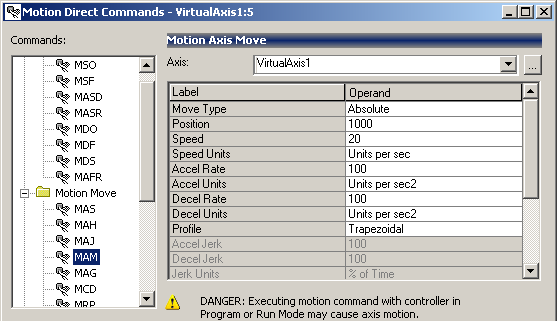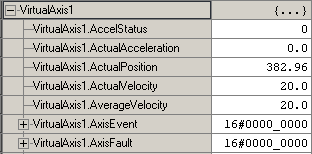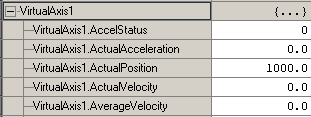Introduction to the Motion Axis Move (MAM) Command
The Motion Axis Move command will allow us to move an axis to a particular position. For example: If we know a product is at a certain position, we can move an axis to that particular location. There are two main types of moves: Absolute, and Incremental. With an absolute move, we can move the axis to a certain position with respect to the home position. In an incremental move, we can move the axis a certain number of units from our current location.
For this example, we will be using a Motion Direct command. If you are unfamiliar with how to use motion direct commands, please read up on this document.
Again, we will be assuming that no motion can take place, and we will use a virtual axis in this document. If you are using an actual axis, please ensure that no harm can be done when the axis is moved. A servo that is unbolted can even jump off the table!
Set up the command
In our example, we will set up the command as follows:

Our move type will be absolute. This means that we will move the axis 1000 inches from the home location based on the position that we have entered.
The speed will be 20 inches per second. This will allow us enough time to actually see the axis moving.
Our acceleration rate will determine how long the axis will take to come up to full speed. Likewise, as the axis approaches the target position, the axis will start decelerating.
Since we are using a trapezoidal move, the acceleration will be purely in units per second squared. With an S-Curve profile, we will implement a “Jerk” setting. This, in a way is like an acceleration rate of the acceleration rate. It determines how fast we will achieve the target acceleration.
In newer versions, there is also a “Merge” feature. This feature is beyond the scope of this documents, but it allows you to merge this command with other commands that might currently be executing.
When you are ready to see the movement, press the “Execute” Button.
Monitor the Axis
After we press execute, you will see the axis begin to move. Remember if you are trying this on an actual axis, you will need to execute an MAM command first.

While watching the Controller tags, you will see the axis come up to speed and the position will begin to increment.

The velocity of the axis is running at 20 inches per second after full speed is achieved. Once the axis reaches the target of 1000 inches, the axis is in position, and will stop. The velocity will go to zero.

The MAM is one of the most common commands used in motion control. This allows for precise movement of an axis to a particular position for the purpose of picking up a product or even diverting a conveyor segment to a particular location.
Again, you can execute an MAH command to return the values to zero.
In the next document, you can learn about Motion Axis Gearing!
— Ricky Bryce
